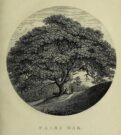Cross (destroyed): OS Grid Reference – SJ 2534 7208
Archaeology & History

This long-gone site, described in the Domesday Record of 1086 as Atiscros Hund, (or “hundred”, which is the word given to an administrative division of land which, at that time, was on the western edge of Cheshire bordering Wales), gained its title from an old English personal name, Æti. The fact that it stood on an ancient boundary and was included in Domesday, means it would have been a stone cross. Its location was shown on the 1871 Ordnance Survey map (and several subsequent ones), based on traditional accounts about its position. The site is still preserved in local street-names.
Referring to the monument itself, Thomas Pennant (1796) said that it still existed in his day, telling that,
“A cross stood there, the pedestal of which I remember to have seen standing. There is a tradition that, in very old times, there stood a large town at this place; and, it is said, the foundations of buildings have been frequently turned up by the plough.”
References:
- Dodgson, J.M., The Place-Names of Cheshire – volume 4, Cambridge University Press 1972.
- Pennant, Thomas, The History of the Parishes of Whiteford and Holywell, B. & J. White: London 1796.
- Taylor, Henry, Historic Notices, with Topographical and other Gleanings Descriptive of the Borough and County-Town of Flint, Elliot Stock: London 1883.
© Paul Bennett, The Northern Antiquarian
The map could not be loaded. Please contact the site owner.

